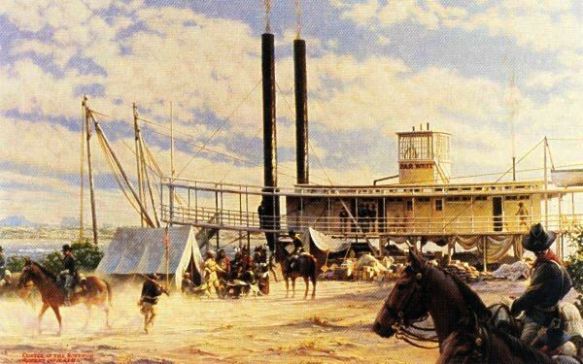
“Gone with the Wind” published
Margaret Mitchell’s Gone with the Wind, one of the best-selling novels of all time and the basis for a blockbuster 1939 movie, is published on June 30, 1936.
In 1926, Mitchell was forced to quit her job as a reporter at the Atlanta Journal to recover from a series of physical injuries. With too much time on her hands, Mitchell soon grew restless. Working on a Remington typewriter, a gift from her second husband, John R. Marsh, in their cramped one-bedroom apartment, Mitchell began telling the story of an Atlanta belle named Pansy O’Hara.
In tracing Pansy’s life from the antebellum South through the Civil War and into the Reconstruction era, Mitchell drew on the tales she had heard from her parents and other relatives, as well as from Confederate war veterans she had met as a young girl. The story presents a romanticized view of the Old South and does not engage with the horrors of slavery. While she was extremely secretive about her work, Mitchell eventually gave the manuscript to Harold Latham, an editor from New York’s MacMillan Publishing. Latham encouraged Mitchell to complete the novel, with one important change: the heroine’s name. Mitchell agreed to change it to Scarlett.
Published in 1936, Gone with the Wind caused a sensation in Atlanta and went on to sell millions of copies in the United States and throughout the world. The book drew criticism for its whitewashed depictions of slavery. Mitchell nonetheless won the Pulitzer Prize for Fiction in 1937, and by that time a movie project was already in the works. The film was produced by Hollywood giant David O. Selznick, who paid Mitchell a record-high $50,000 for the film rights to her book.
After testing hundreds of unknowns and big-name stars to play Scarlett, Selznick hired British actress Vivien Leigh days after filming began.
Though she didn’t take part in the film adaptation of her book, Mitchell did attend its premiere in December 1939 in Atlanta. She died just 10 years later, after she was struck by a speeding car while crossing Atlanta’s Peachtree Street.

WESTWARD EXPANSION
1876
Wounded soldiers evacuated from the Little Big Horn by steamboat
After a slow two-day march, the wounded soldiers from the Battle of the Little Big Horn reach the steamboat Far West. The Far West had been leased by the U.S. Army for the duration of the 1876 campaign against the Sioux and Cheyenne tribes of the Northern Plains.

COLD WAR
1974
Soviet dancer Mikhail Baryshnikov defects from U.S.S.R.
Considered one of the world’s greatest ballet dancers of all time, Soviet virtuoso Mikhail Baryshnikov choreographs his own Cold War-era defection from the U.S.S.R.

19TH CENTURY
1859
Daredevil crosses Niagara Falls on tightrope
Jean Francois Gravelet, a Frenchman known professionally as Charles Blondin, becomes the first daredevil to walk across Niagara Falls on a tightrope. The feat, which was performed 160 feet above the Niagara gorge just down river from the Falls, was witnessed by some 5,000.

ANCIENT AMERICAS
1520
Spanish retreat from Aztec capital
Faced with an Aztec revolt against their rule, forces under the Spanish conquistador Hernán Cortés fight their way out of Tenochtitlan at heavy cost. Known to the Spanish as La Noche Triste, or “the Night of Sadness,” many soldiers drowned in Lake Texcoco.

SPACE EXPLORATION
1971
Soviet cosmonauts perish in reentry disaster
The three Soviet cosmonauts who served as the first crew of the world’s first space station die when their spacecraft depressurizes during reentry. On June 6, the cosmonauts Georgi Dobrovolsky, Vladislav Volkov, and Viktor Patsayev were launched into space aboard Soyuz 11.

WORLD WAR II
1934
Hitler purges members of his own Nazi party in Night of the Long Knives
In Germany, Nazi leader Adolf Hitler orders a bloody purge of his own political party, assassinating hundreds of Nazis whom he believed had the potential to become political enemies in the future. The leadership of the Nazi Storm Troopers (SA).

ART, LITERATURE, AND FILM HISTORY
1989
“Do the Right Thing” released in theaters
On June 30, 1989, the writer-director Spike Lee’s celebrated third feature film, Do the Right Thing—a provocative, racially charged drama that takes place on one block in Brooklyn’s Bedford-Stuyvesant neighborhood, on the hottest day of the year—is released in U.S. theaters.
CRIME
1981
A first-time offender ends up on the FBI’s Ten Most Wanted List
Glen Godwin, a young business owner, is convicted of murder in Riverside County, California, and sentenced to 26-years-to-life in prison. According to his roommate’s testimony, Godwin stomped on, choked, and then stabbed Kim LeValley, an acquaintance and local drug dealer.
TODAY IN NIGERIA HISTORY
1849 Britain established a colonial protectorate over the Bight of Biafra under the authority of the British Consuls of the Bight of Benin


2010 President of Nigeria Goodluck Jonathan announced he would suspend the Nigeria Football Federation from FIFA competition for 2 years.
Comments
Post a Comment